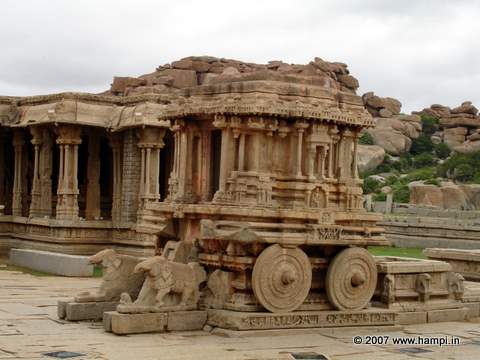Stone Chariot

Wheels of Stone Chariot in Hampi
Wheels of Stone Chariot in Hampi. This is located inside the Vittala Temple complex.
T
he "Stone Chariot", as it is often referred is the flagship tourist attraction of Hampi. This is not a chariot ,as the name suggests, rather a shrine built like a chariot. This is located inside the Vittala Temple campus. You would be visiting the Stone Chariot as part of your Vittala Temple tour.In mythology Lord Vittala is an aspect of Lord Vishnu (See Gods of Hampi and Mythology of Hampi). Garuda (lord of eagles) is the vehicle (mount) of Lord Vishnu. The Stone Chariot once contained the icon on Garuda, though the shrine is empty now. This shrine is in the axis of the massive Vittala Temple and faces the sanctum of Vittala Temple.
It may appear to you (and sometimes even referred to) as a monolithic structure. In reality this stone shrine was built with many giant granite blocks. The joints are smartly hidden in the carvings and other decorative features that adorn the Stone Chariot.
The chariot is built on a rectangular platform of a feet or so high. All around this base platform is carved with mythical battle scenes. Though the chariot is not resting on it, the four giant wheels attached mimic the real life ones complete with the axis shafts and even the brakes. A series of concentric floral motifs decorate the wheels. It appears from the marks on the platform, where the wheels rest, the wheels were free to move around the axis.
You can still see the remains of the painting on the carvings of the chariot. Probably because it was relatively protected from the natural weather elements, the undercarriage of the chariot spots one of the best preserved specimens of this kind of paintings. It is believed the whole of the Vittala Temple’s sculptures were once beautifully painted in similar fashion using the minerals as medium.
In front of the chariot two elephants are positioned as if they are pulling the chariot. In fact these stone elephants were brought from elsewhere and positioned here at a later stage. Originally two horses were carved in that position. The tails and the rear legs of the horses can be still seen just behind these elephant sculptures. A broken stone ladder once gave access to the sanctum is kept between the elephants. You can still spot the marks on the floor and the doorsill where once the ladder stood.
There was even a dome like superstructure over the chariot. That too is missing now. However you can see them on the first ever photographs of Hampi taken in 1856 by Alexander Greenlaw.
Vittala Temple and the Stone Chariot inside are must do things in your Hampi itinerary. And also don't miss that customary photo opportunity with the stone chariot as your background!

Stone Chariot
The Garuda (eagle) shrine in the form of a chariot inside the Vittala Temple complex

The terracotta made superstructure of the Stone Chariot has crashed or was pulled down for some mysterious reasons, probably to save the rest form collapsing. Most likely this happened during the colonial period when the conservation efforts were made under the Madras Presidency. The old photographs taken by Greenlaw, Lyton etc give a good idea of the changes that happened to these structures on a century.
The terracotta made superstructure of the Stone Chariot has crashed or was pulled down for some mysterious reasons, probably to save the rest form collapsing. Most likely this happened during the colonial period when the conservation efforts were made under the Madras Presidency.
The old photographs taken by Greenlaw, Lyton etc give a good idea of the changes that happened to these structures on a century.

The two elephants that appear in front of the chariot as if they are pulling it, do not belong this structure. The elephants where brought from else where and kept in front of the Chariot. Originally it was two horses, that was part of the Stone chariot. You can still see the hind legs and tail of the horse sculpture.
The two elephants that appear in front of the chariot as if they are pulling it, do not belong this structure. The elephants where brought from else where and kept in front of the Chariot. Originally it was two horses, that was part of the Stone chariot. You can still see the hind legs and tail of the horse sculpture.

The "Chariot" never moved , unlike those wooden temple cars used in the temple festival ceremonies. What probably moved was its four wheels around its axle, all made of granite.
The "Chariot" never moved , unlike those wooden temple cars used in the temple festival ceremonies. What probably moved was its four wheels around its axle, all made of granite.

There are many interesting facts associated with the iconic 'Stone Chariot'.
It's a shrine meant for Garuda, the mount of Lord Vishnu.
It may appear to you (and sometimes even referred to) as a monolithic structure. In reality this stone shrine was built with many giant granite blocks. The joints are smartly hidden in the carvings and other decorative features that adorn the Stone Chariot.
